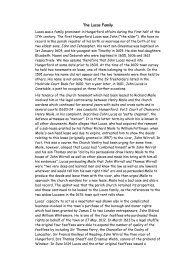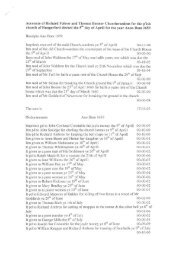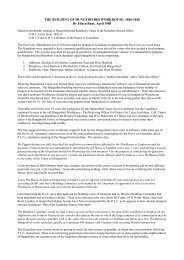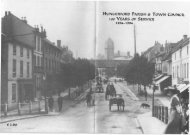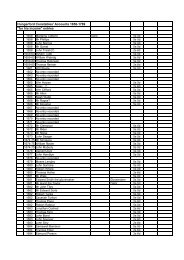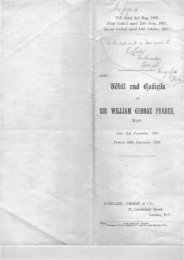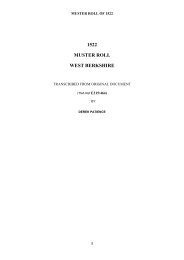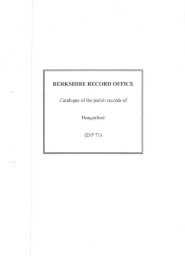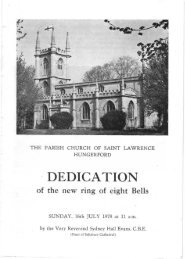The English Country House and Chilton Lodge - Hungerford Virtual ...
The English Country House and Chilton Lodge - Hungerford Virtual ...
The English Country House and Chilton Lodge - Hungerford Virtual ...
Create successful ePaper yourself
Turn your PDF publications into a flip-book with our unique Google optimized e-Paper software.
<strong>The</strong>y come in all shapes as well. From the fortified manor houses of the 14C, through<br />
Tudor, Elizabethan, Carolean, Commonwealth, Jacobean, Georgian, Victorian, Edwardian<br />
styles right up to the modern day, there has been a continuous <strong>English</strong> tradition of<br />
building <strong>and</strong> remodelling country houses. Some of them look as though demented<br />
children stuck them together with bits from every architectural style imaginable; others<br />
have a geometric precision <strong>and</strong> unity that is almost impossible to believe.<br />
Fashions change. Until the 18C, the '<strong>English</strong>' vernacular style had dominated, slowly<br />
evolving over centuries <strong>and</strong> reflecting changes in society away from feudal towards more<br />
enlightened social criteria. As a result of the Gr<strong>and</strong> Tour <strong>and</strong> increasing continental<br />
influences in <strong>English</strong> life, the 18C became a century of great experiment both in the<br />
design <strong>and</strong> alteration of houses, <strong>and</strong> in the l<strong>and</strong>scaping of parks <strong>and</strong> estates. Some put<br />
classical facades on older houses (Welford); others built houses (Basildon Park) from<br />
scratch. As we heard in this room last year, the same phenomenon was happening in<br />
urban architecture, in towns such as <strong>Hungerford</strong>, where older houses were refaced with<br />
gr<strong>and</strong> Georgian fronts.<br />
Vita Sackville-West writing at the end of the 19C best sums up how some traditionalists<br />
felt about the new neo-classical order. '<strong>The</strong> great Palladian houses of the eighteenth<br />
century are in Engl<strong>and</strong>, they are not of Engl<strong>and</strong>.' I imagine she delivered her stinging<br />
epithet in tones reminiscent of Edith Evans.<br />
I remember once seeing a quotation from Bosworth or Johnson on the flyleaf of the<br />
Visitors Book at Easton Neston, which is one of Hawksmoor's finest houses. 'Mr.<br />
Hawksmoor has built a new house that comm<strong>and</strong>s an offensive view over the town of<br />
Towcester.' Ouch! Anyway, the classicists more or less had it their way for more than<br />
150 years until, first under the Regency <strong>and</strong> then under Queen Victoria, owners <strong>and</strong> their<br />
architects started to hark back to the Gothic <strong>and</strong> medieval ideals.<br />
In the 19C, the Arts & Crafts Movement did much to revitalise craftsmanship in an<br />
increasingly mechanical age <strong>and</strong> contributed a great deal to the renovation of old manor<br />
houses that had been suffering from benign neglect whilst the Georgians were building<br />
their glittering boxes. However, as fortunes were made so quickly in Empire <strong>and</strong> Industry,<br />
so grew the dem<strong>and</strong> for ever more ostentatious <strong>and</strong> extravagant houses. Building new<br />
houses <strong>and</strong> extending old ones to house collections of paintings, furniture <strong>and</strong> works of<br />
art, as well as large retinues of servants, laundries, breweries, etc. <strong>and</strong> to cater for the<br />
enormous house parties that were the vogue, became a sort of mania for both the 'new<br />
rich' <strong>and</strong> the 'old still rich' as the 19C drew to a close.<br />
Needless to say, the Victorian <strong>and</strong> Edwardian excess could not carry on forever. Indeed,<br />
owners whose primary income came from agriculture were increasingly under the hammer<br />
throughout the agricultural depression of the 1870's - 1890's. <strong>The</strong> First World War<br />
changed everything in British society, not least for the country house <strong>and</strong> its owner.<br />
Many owners faced more than one imposition of swingeing death duties within a few<br />
years, if not directly caused by war, then from the Spanish flu epidemic that followed.<br />
You only have to listen to the Roll of Honour on Remembrance Sunday in any village<br />
church to underst<strong>and</strong> that it would be impossible after 1918 to recruit the domestic staff<br />
that was essential to the running of the largest country houses. It is also easy to forget<br />
that the period between the two world wars was of the same duration as the period from<br />
the Falkl<strong>and</strong> War until today, but the 1930's encompassed the second big agricultural<br />
depression within 50 years.<br />
For many owners, their old houses, often bloated beyond recognition by Victorian<br />
additions, became an intolerable burden. For some, the pursuit of the Turf <strong>and</strong> the green<br />
baize proved their undoing. <strong>The</strong> boom in the construction <strong>and</strong> extension of country<br />
houses that had lasted from the 1840's until the 1910's went into sharp reverse from the




